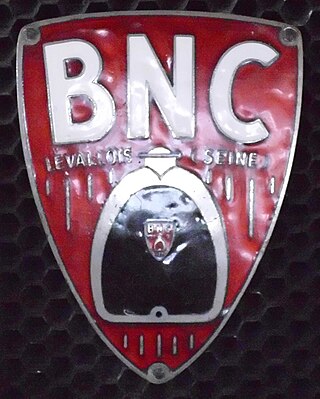The Able was a small French cyclecar made in Avignon by Paul Toulouse, built between 1920 and 1927.

Baconin Borzacchini was an Italian racing driver who often competed under the nom de courseMario Umberto Borzacchini.

The Alfa Romeo 8C was a range of Alfa Romeo road, race and sports cars of the 1930s.

The 1923 24 Hours of Le Mans, officially the 24 Hours Grand Prix of Endurance, was the inaugural Grand Prix of Endurance, and took place on 26 and 27 May 1923.
The 1928 24 Hours of Le Mans was the 6th Grand Prix of Endurance that took place at the Circuit de la Sarthe on 16 and 17 June 1928.

The GN was a British cyclecar made in London, between 1910 and 1925, The name derived from its founders, H.R. Godfrey and Archibald Frazer-Nash. Production ceased in 1923 but the company kept trading until 1925.
The Kevah was a French automobile manufactured from 1920 until 1924. Built by Muller, Allen-Sommer and Robert at La Garenne-Colombes, the cyclecar had vee-twin 1100 cc Train or MAG engines, and was considered well-made. The company offered a four-cylinder 898 cc sv Chapuis-Dornier-powered car with three-speed gearbox in 1923.

The Amilcar CGS Grand Sport was a popular inter war lightweight sports car, manufactured by the French automobile maker Amilcar between 1923 and 1925. A response to the successful Salmson VAL3 series, the "C Grand Sport" was developed from the Amilcar C. The CGS had a longer, more rigid chassis, and improved brakes in addition to its bigger engine.

Bollack, Netter, et Cie(French: Bollack Netter et compagnie), more commonly known as B.N.C., was a small French automobile company in Levallois-Perret, situated on Avenue de Paris 39.

S.C.A.P. was a French manufacturer of cars and proprietary engines, existing between 1912 and 1929.

Salmson is a French engineering company. Initially a pump manufacturer, it turned to automobile and aeroplane manufacturing in the 20th century, returning to pump manufacturing in the 1960s, and re-expanded to a number of products and services in the late 20th and into the 21st century. It is headquartered in Chatou and has production facilities in Laval. It has subsidiaries in Argentina, Italy, Lebanon, Portugal, South Africa and Vietnam.

Ruby was a French manufacturer of cyclecars. After automobile production ended they remained in business as an engine builder.

The Bignan was a French automobile manufactured between 1918 and 1931 on the north side of central Paris, in Courbevoie. The business was created, and till the mid-1920s, headed-up by Jacques Bignan.

The Salmson S4 is a mid-size executive-level car introduced as the Salmson S4 C by Société des Moteurs Salmson in Autumn 1932. It was the manufacturer's principal and often sole model for the next twenty years.

Sénéchal was a French automobile manufacturer between 1921 and 1929.

Benjamin was a French manufacturer of cyclecars between 1921 and 1927 and based on the north-west edge of Paris. 1927 was a year of changes which included a name change, and between 1927 and 1929 the company operated under a new name, Benova.
Chapuis-Dornier was a French manufacturer of proprietary engines for automobiles from 1904 to 1928 in Puteaux near Paris. Between 1919 and 1921 it displayed a prototype automobile, but it was never volume produced.

The Autocrat was a British car manufacturer operating from 1913 to 1926. The company operated from premises in the Balsall Heath area of Birmingham. Unusually for the time the company seems to have been run by two women, Ivy Rogers and Miss Howell.
José Behra was a French racing driver and rally driver.

Anne-Cécile Rose-Itier was a French multi-talented automobile driver and co-driver, competing in rallies, hill climbs, circuits, and endurance events.

















